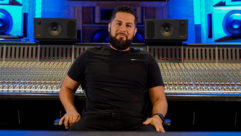
Top Tech of 2006
Dec 1, 2006 11:00 AM,
By Jack Kontney
A review of award-winning products for the installation industry.

Remote Technologies T4
New product introductions continue at a breakneck pace in virtually all categories impacting the installation industry. The seemingly endless announcements happen on tradeshow floors, on websites, in magazines, and at sales meetings. Amid this flurry of activity, how can one separate the litter from the glitter, the sizzle from the steak?
For contractors and integrators, it’s an ongoing balancing act between offering clients the latest and greatest technology and recommending the tried-and-true solutions. While the latter is safe and effective, sticking with “old reliable” equipment can sometimes have a negative effect on your reputation as a solution provider.
But jumping on the high-tech bandwagon has its own downside. Products without a track record in the field are looked upon with understandable suspicion. Will the product deliver on its promises? What is the learning curve for both the installer and the user? Is this a final product or a public beta? Can the manufacturer be relied upon for support after the sale, especially if something goes wrong in the field?
In other words, to sum it up in a language we can all understand: Will there be callbacks?
This article examines some of the more prominent new products targeting the installation community that were introduced during 2006. Since space precludes covering every technology that made waves during the year, we are using the time-honored method of looking at the industry’s major tradeshows and examining the products that won awards either at those shows, or from Sound & Video Contractor. Specifically, the Pick Hit awards at InfoComm (svconline.com/mag/avinstall_infocomm_pick_hits), the Innovations in Technology Awards at NSCA (svconline.com/mag/avinstall_nsca_award_winners), and/or the Manufacturers’ Excellence Awards (svconline.com/tradeshows/products/avinstall_cedia_awards) from the recent CEDIA show.

Crestron Adagio
SOUND PRODUCTS
One crucial product to come out in 2006 was the Shure UHF-R wireless system. This system truly takes live performance wireless to a new level, with 2,400 selectable frequencies spread across 60MHz of bandwidth. Shure estimates 108 systems can be operated simultaneously, and the UHF-R’s networking capabilities actually make that a manageable task via either USB or Ethernet control. Features like Shure’s proprietary Audio Reference Companding help greatly improve sonic performance, taking full advantage of the new dual-pattern KSM9 mic capsule offered on the handheld version.
At the other end of the audio chain hang the loudspeakers. In demonstrations at InfoComm, the new M’elodie system from Meyer Sound reinforced its firm’s ongoing mastery of self-powered loudspeaker design. Designed as a powerful yet compact line array, the M’elodie has an exceptional power-to-size ratio, with 131dB SPL peak output available. Perfect for use as the main house system in nightclubs and small theaters, it has also been designed as a complement to the firm’s Mica system in downfill, frontfill, and under-balcony applications. The M’elodie features 100-degree horizontal dispersion, modest weight, and a low profile, and uses Meyer Sound’s QuickFly hardware system for both hanging and ground-stacked configurations.
On the home front, loudspeakers take a different form factor. A recent entry into the “invisible” category is the Model A3 from Stealth Acoustics. This three-way, full-range panel speaker incorporates a paintable active diaphragm face that attaches to standard structural framing without special hardware. The facing area comes pre-primed, with panel edges tapered like gypsum wallboard, allowing the panel to accept wallboard tape and joint compound. Finishing options include light wallpaper or fabric, latex paint, and certain texture coats. In short, the A3 offers high-fidelity audio performance with full architectural integration, making it ideal for construction-based home theater installations.
Speaking of home audio, Crestron’s Adagio entertainment system is drawing a lot of attention as a multi-room audio distribution system that can be easily expanded to cover a full range of home automation functionalities. The Adagio supports up to six sets of stereo speakers, each of which can access up to 10 stereo sources. A “group” feature allows adjacent rooms to be linked, while a full-house party mode allows all rooms to function as one. The Adagio simplifies access to the user’s entire audio collection by accommodating a wide variety of audio sources, including Crestron’s AAS audio server and iPod interface, plus standard and satellite radio tuners. For system control, a choice of basic 12-button keypads or Crestron’s full-function APAD wall-mount LCD controllers is offered, while 2-series Ethernet control allows use of Crestron touchpanels.

Midas XL8
In live performance audio, 2006 will be remembered as the year that Midas released its first digital mixing console. The XL8 uniformly wowed the curious crowds, making it clear that Midas had taken its time and done it right. With capabilities too vast to list here, suffice it to say that the new Midas digital system is based around dual-redundant master control processors working in a reliable Linux environment. Classic Midas values like audio quality and roadworthiness are emphasized, but they are also balanced with an intuitive operating environment that will comfort longtime analog users. Seamless emulation is the best way to describe how this 96-channel console embraces digital functionality as an open-architecture, cross-platform, integrated audio control and distribution system.
Of course, you can’t have sound without power. A Swedish firm, Lab.gruppen, is making a huge splash in the U.S. installation market with the contractor-friendly C series range. Each of the eight models is fully configurable for maximum peak voltage and gain so that lo-Z and 70V devices can be powered from the same unit, offering flexibility that can easily accommodate changes in client requirements. The flagship, model C 68:4, offers a total of 6800W at 4Ω in only 2RU of space. A combination of individually configurable per-channel voltage peak limiters, network control of linked units, and front-panel lockout ability complete this robust, flexible concept in amplifier design.
All the buzz in the audio world is about networking. In particular, the Aviom Pro64 product series is getting a lot of attention for its uncompromising high fidelity. Using Aviom’s innovative A-Net audio networking protocol, the Pro64 system creates an uncompressed, 24-bit bidirectional audio network system with extremely low latency. It supports continuously variable sample rates from 44.1MHz to 192MHz, as well as connection topologies. By working outside the Ethernet network, the Pro64 eliminates latency issues inherent in packet switching and delivers archival-quality audio.
Another stalwart of the industry, Biamp, announced the expansion of its AudiaFlex line with the Nexia TC digital signal processor. Packaging exceptional teleconferencing performance into a new cost-effective 1RU package, Nexia TC offers eight wideband AEC mic/line inputs, two standard mic/line inputs, four mic/line outputs, and both RS-232 and Ethernet ports. The onboard telephone interface capabilities include line echo cancellation, TouchTone decoding, caller ID reception, detection of call progress, and line intrusion. The Nexia TC comes with Nexia software for full PC control, including the view and control of all effects and diagnostics.
Perhaps the most visually arresting award winner among the audio products this year is from a new company, Revolabs. Its new Solo secure conferencing system boasts a unique form factor and incredible ease of operation, making it perfect for boardroom applications. The Solo Executive is a full-duplex wireless system that incorporates automated setup and 128-bit encryption for eight microphone transmitters housed in a charging base station. The microphones are uniquely lightweight, clip-on tubes that activate and find themselves an open channel when removed from the dock. The rackmount receiver decrypts and sends the audio to the boardroom audio system. Revolabs also offers the Solo Desktop, a single-channel version suitable for hands-free VoIP in executive offices.
VIDEO PRODUCTS
Today’s video is all about resolution, control, and of course, screen size. But the biggest new video market is in digital signage, using the power of visual communication to reach audiences with the right message in the right location.

Lab.gruppen C series
The new ND4200 from ViewSonic uses IP networking to transfer virtually any content imaginable to a 42in. high-definition plasma display. The system’s network module incorporates a Mozilla browser via a Linux operating system to seamlessly repurpose Web content, audio, and video as digital signage content. The processor includes a Flash player and built-in MPEG-1/2/4 decoder for digital audio and video, and offers a programmable full-screen mode that easily removes annoying content elements like toolbars, borders, and address lines. Designed for large-scale custom display networks, the ND4200 system is fully compatible with Cisco networks and provides simplified installation and low cost of ownership by eliminating the need for local PCs.
Avocent has taken video streaming to a new level with the introduction of the Emerge EWMS1000, which broadcasts high-quality, full-motion video to multiple display devices while eliminating the need for a PC at every destination, reducing both costs and installation time. Emerge handles all common computer and video inputs and outputs and has built-in AES encryption for secure wireless connectivity. The system outputs 30fps (MPEG-2 D1) and transmits 1,000ft. line of sight and up to 250ft. through walls using the 802.11a radio standard.
For simultaneous display of multiple visuals on a single screen, Extron offers the MGP 464 and 464 DI four-screen, high-resolution processors. The 464 combines video, HDTV, and high-resolution RGB inputs (19 in all) to allow display of up to four windows, each individually controllable for size, location, priority, border color, and zoom. This 2RU processor uses Extron’s Simple Instruction Set (SIS) remote control. With 48 selectable output rates and simultaneous output of RGB, HDTV, component video, and DVI, the Extron 464 processors are powerful, easy to use, and compatible with virtually any display device.
In terms of system control, the Sony Ipela PCS-HG90 codec is notable for its ability to preserve HD video quality through transfer over IP networks. Applications that suggest themselves as candidates for this functionality include videoconferenced shareholder meetings and, of course, live HD video production. This unit, which supports the H.264 video protocol, manages to transfer 1280×720p video imagery through a maximum required bandwidth of only 8Mbps, signaling Sony’s commitment to the installation market through the Ipela product line.
For professional production without professional staff, Broadcast Pix created the Slate 100, a PC-based integrated production environment. Designed for use with a touchpanel monitor, the Slate 100’s intuitive multi-view design allows full production capability by a single operator, or allows multiple operators to work together by using SoftPanel, a browser-based, touch-powered screenview that emulates the layout and functionality of a classic program/preview switcher. Just add a touchscreen monitor and you’re ready to roll.
On the “big picture” front, Optoma has opened new architectural horizons with its Bigvizion 100, a high-definition, in-wall, rear-projection television. Using a proprietary light engine based on DLP micro-mirror technology, this customizable rear-projection TV requires only 30in. of depth, making it ideal for fixed installations. Available with 80in., 90in., and 100in. diagonal screens, the Bigvizion 100 offers advanced connectivity and can display all signal sources as 1080p HD native. This well-engineered design also offers a customizable bezel to match room décor, and offers easy service access through the screen assembly, making it a great match for high-profile installations and high-technology integrators alike.
The first curved viewing screen designed for home use, the CineCurve from Stewart Filmscreen uses the 2.35:1 aspect ratio associated with CinemaScope film production, making it ideal for use with today’s anamorphic lens video projectors. To accommodate other aspect ratios, the CineCurve features a masking system, with electronically controlled side panels creating the proper screen area. Home viewers will appreciate the constant image height, elimination of pin-cushion effects, and higher perceived brightness inherent in the slightly concave shape, which has the additional advantage of limiting the washout effect of light bouncing off the side walls of the viewing room.
Addressing the CinemaScope home viewing market from the projector standpoint is Runco’s RS-1100 CineWide with AutoScope projection system. The patent-pending CineWide projector’s anamorphic lens is motorized and remote controlled through the AutoScope option. When switching from standard 16:9 to 2.35:1 aspect ratio, the RS-1100 eliminates the annoying black bars at the top and bottom of the viewing screen by maintaining full image height and making the image wider. This is accomplished through a combination of software, electronics, and precision optics for a seamless home theater experience.
Outside the home, bigger is not always better. 3M has met the challenge of short-throw video projection for small offices with the Digital Media System 700. Using Vikuiti Super Close Projection technology, these compact projectors can produce a 60in.-diagonal image from only 30in. away, so the projector can be kept in front of the presenter and used in even the smallest of spaces. Give it 89in. of projection space and the Digital Media System 700 will produce a clear, sharp 180in.-diagonal image. The system also incorporates Dolby sound and can be operated by remote from your PC or have programming loaded onto it from a memory stick, allowing users to bring full multimedia functionality to any meeting space.

Extron MGP 464
Among the first DLP projectors to offer 1920×1080 performance, the Barco FLM HD18 is the quietest 18,000-lumen, native HD projector on the market. Enhancing the performance of this compact unit is a patent-pending, liquid-cooled, fully sealed optics system. The rental and staging markets are also addressed through low lamp maintenance and the ability to use Barco RLM and SLM lenses, resulting in exceptionally low cost of ownership. The FLM HD18 brings high brightness and native HD picture quality together in a near-silent front-projection design without compromise.
OTHER TOOLS
With all forms of media being networked together across a wide array of protocols these days, there are, quite simply, too many unique products that deserve the attention of the contracting market, but which do not fall neatly into the specific audio or video categories. We still call these “contractor” products because many of these units are tools to make design and installation of premium home and commercial systems a more manageable task.
Among the chief beneficiaries of media convergence and IP control are safety and security systems. The TOA N-8000 creates exceptional intercom functionality for up to 1,280 stations while using a modest amount of IP bandwidth. Using TOA’s NX-100 audio networking, the N-8000 offers station-to-station calling, up to 160 paging zones, time-based call forwarding, and scan monitoring. The backbone of the system is the N8000EX exchange, which supports 16 stations and includes a 10/100BaseT port for connection to standard network hardware. The N-8000 station lineup includes both two-wire and Ethernet options, and a wide variety of master station and substation designs for whatever environmental conditions might be encountered.
One thing that’s a constant source of problems for designers and integrators is the complexity of using IP control over several layers of functionality. SystemBuilder 2.0 from Crestron addresses that issue head-on. Designed as an end-to-end system design tool for use with the firm’s MediaManager control system, the SystemBuilder software suite automatically generates equipment lists, configures all the inputs and outputs, and even writes the control code for outboard gear, such as PCs, DVD players, and projectors. To complete the package, wiring diagrams, bills of materials, and purchase orders can be generated directly from the software, taking the high anxiety out of high technology.
AMX had a busy year in 2006, as evidenced by award-winning products in both the software and hardware areas. VisualArchitect is a software suite that combines sales tools, system design, a visual programming environment, and installation guides. Using drag-and-drop functionality to create a system running on an AMX Master Controller, VisualArchitect makes it easy to demonstrate how a new system will come together, then continues the thought through the programming and installation phases.
The AMX Mio Modero keypads offer dynamic menu control in a sleek, user-friendly design that allows speedy search of hundred of lines of text, such as CD/DVD titles. Measuring 4.5″×3.6″ with 128×240-pixel, 3.75in. displays, both the Mio DMS and DMS-P offer eight-button control of virtually infinite function lists. The DMS-P Pinnacle adds a slider control for rapid access to multiple screens. Both units offer 32MB of RAM and 16MB of Flash memory and are easily programmed using KeypadBuilder 1.1.
Remote Technologies (RTI) enriches the home video experience with the T4 universal remote, a sleek, ergonomic touchscreen design. The T4 includes direct IR control for standalone operation, RF output for control processor operation, and WiFi for IP control and Internet access. At 6.4in., the T4 offers sufficient screen size to display VGA video and Web pages while still remaining a truly handheld device. Using RTI’s TheaterTouch Designer software, full customization is easily obtained. Onboard stereo speakers, 32MB of Flash memory, and a stylish docking station are included.
The larger the installation, the more is at stake. ETA will help put your mind at ease with its three-phase Conditioned Power Center. These custom units go far beyond the 20-amp power conditioners common to our industry, providing clean, conditioned, isolated power for even the biggest installation. The Conditioned Power Center series offers models with load-handling capabilities from 10kVA to 300kVA. All can reduce a 6,000V surge to less than 10V (hot to neutral) and less than .5V (neutral to ground). Each unit comes fully equipped with a low-impedance isolation transformer, surge diverter, and noise filter, and is manufactured to installation specifications.

Optoma BigVizion
The Sencore Audio Integrator (SP395) and Audio Consultant (SP495) are rugged handheld analyzers designed specifically for our industry. The Audio Integrator is an acoustic analyzer with a high-resolution color LCD, dual-FFT processing, bidirectional stereo audio USB interface, and both digital and analog audio outputs. It includes an impulse recorder to use as input to acoustic analysis programs, a stereo recorder, and a standard SD memory card for transferring WAV files. The Audio Consultant includes a sound level meter, noise dosimeter, energy graph, and impedance meter. Both are rugged handheld devices designed for onsite fieldwork.
That’s an overview of some of the key award-winning products for 2006. But there’s one more thing that both contractors and manufacturers might want to see. Each year, NSCA recognizes a manufacturer’s website with an Innovations in Technology Award, and there is no doubt that Extron’s site is worthy of this recognition. The site, www.extron.com, combines high-level functionality with streamlined design and intuitive navigation. The home page features a user-friendly array of functions, including one-click access to every model, and direct access to sites dedicated to AV consultants, the education market, and product training. Using text instead of GIFs and Flash on the site ensures fast load times and search-engine friendliness. This is a fine example of a well-conceived, well-executed business site that puts users first. There are many in our industry who could benefit from this simple lesson.
Jack Kontneyis a longtime industry professional and founder of Kontney Communications, a Chicago area marketing and content creation firm. Visitwww.kontneycomm.comto contact him.










